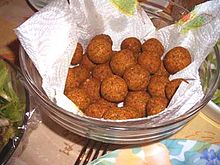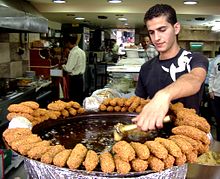Falafel


Falafel (Arabic: فلافل ; Coptic: Ⲫⲁⲗⲁⲫⲉⲗ fal`ahfel; Greek: Φαλάφελ; also known in Egypt and Sudan as ta'meya, Arabic طعمية), is a fried ball or patty made from spiced fava beans and/or chickpeas. Chickpeas originate in countries with semi-arid regions. It is a popular form of fast food in the Middle East. Falafel has been brought over to Europe and is available in Middle Eastern and Turkish eateries and is served as a mezze (snack or starter).
The word "falafel" is the plural of the Arabic word فلفل (filfil), meaning "pepper".[1] Variant spellings in English include felafel and filafil.
Falafel is generally served in pita bread, either inside the pita, which acts as a pocket, or wrapped in a flat pita. In many countries, falafel is a popular street food or fast food. The falafel balls, whole or crushed, may be topped with salads, pickled vegetables and hot sauce, and drizzled with tehina (tahini). Falafel balls may also be eaten alone as a snack or served as part of a mezze. During Ramadan, they are sometimes eaten as part of an iftar, the meal which breaks the daily fast after sunset.
Falafel has been part of the diet of Arabs, Copts and Mizrahi Jews for centuries.[2] It is an iconic Palestinian food and is also considered a national food in Israel where it is a common part of the Israeli diet.[3] Now a popular street food in many countries around the world, it is sometimes offered as a vegetarian alternative to Döner kebab.
History
Falafel originated in Egypt, where it was first made with fava beans as the base. The actual origins are not certain, however, all common theories acknowledge that the falafel was invented several centuries ago, either as early as the Ancient Egyptians,[4] or the Copts,[5] who exist to this day as the pure descendants of the Ancient Egyptians. Other beliefs point to the desert Bedouins, who later inter-married with the Arabs.[citation needed] As the dish migrated northwards to Syria and Palestine, chickpeas were introduced instead. The chickpea was used as a food item in the Levant before 4000 BC.[6] Falafel was consumed by Middle Easterners of all religious denominations, notably the Egyptian Copts and Arabs, as well Arabic speaking Jews in Egypt and Syria.[2]
After hundreds of thousands of Jews emigrated to Israel from Arab countries in the 1950s, falafel became an Israeli emblem. The proliferation of falafel stands, operated in particular by Jews from Yemen, made it possible to incorporate elements like falafel without referring to its Arabic associations.[2] A popular Israeli song composed by Dan Almagor in 1958, "And We Have Falafel," included a line claiming falafel as an exclusive Israeli provenance.[2] By the 1970s, Jewish cookbooks included recipes for falafel that made no mention of its Egyptian origins, leading many Arabs to resent the cultural appropriation of this iconic food.[7] Although, as a group that originated in the Middle East, it is questionable whether this controversy is colored by the Arab-Jewish conflict.
Some Israelis and Jews have since recognized the controversy. For example, Ammiel Alcalay, a Jewish professor of Middle Eastern culture, has described the Israeli adoption of falafel as "total appropriation" and Dan Almagor notes that if he were composing his song on falafel today, he would now include a line mentioning the dish's Egyptian origins.[2]
Ingredients
Falafel is made from fava beans or chickpeas or a combination of the two. The Egyptian variation uses exclusively fava beans, while other variations may only use chickpeas. Falafel made exclusively from chickpeas became popular in Israel because of favism, a potentially fatal genetic disease among some Mediterranean Jews causing a hemolytic reaction to fava beans. Unlike many other bean patties, in falafel the beans are not cooked prior to use. Instead they are soaked, possibly skinned, then ground with the addition of a small quantity of onion, parsley, spices (including cumin), and bicarbonate of soda, and deep fried at a high temperature. Sesame seeds may be added to the balls before they are fried; this is particularly common when falafel is served as a dish on its own rather than as a sandwich filling.
Recent culinary trends have seen the chickpea falafel have more success than fava bean falafel. Chickpea falafels are served across the Middle East, and have been popularized by expatriates of those countries living abroad. However, fava-bean felafel continue to predominate in Egypt and Sudan and their respective expatriate communities, and Egyptians are fond of deriding chickpea felafel as inferior.
Variations

Outside the Middle East a Greek-style pita bread is often used as a pocket and stuffed with the different ingredients; in Arab countries a round khubz bread, 'eish' in Egypt, is halved, and the two resulting round pieces are used to create a cigar-shaped wrap. In Arab countries, hummus (chickpeas pureed with tahini) is rarely an ingredient. The usual sauce is tahini (sesame seed paste) thinned with water and lemon. The most common salad ingredients are tomato and parsley. In Lebanon parsley is mixed with chopped mint leaves. It is also common in Syria and Lebanon to add pickles; the two canonical ones are pickled turnip, colored pink with beetroot, and pickled cucumber. Recently, there has been a new "filled" falafel, its center usually consisting of ground meat or minced onions or a boiled egg. These fillings are wrapped by the uncooked falafel mixture, and then deep fried.
The salads or the pita itself may be seasoned with sumac or salt; alternatively, these may be sprinkled on top. In Syria, sumac is widely used.
Related dishes
- In the cuisine of Karnataka, ambode is a fried ball of soaked chickpeas. It is usually flattened and pan-fried, and served with chutney. Alternatively, in South Indian cuisine, paruppu vadai(Tamil)/pappu vadaa/masala vadaa(Telugu) is used to refer to flattened, fried balls (or fritters) of a mix of lentils and chickpeas.
- In Italian cuisine, there is a chickpea fritter called frittata di ceci; other similar Italian dishes include panelle and farinata.
- Acarajé, an Afro-Brazilian street food from the northeastern state of Bahia, are pureed black-eyed peas formed into a ball and then deep-fried in palm oil.
Cultural and literary references
- TV personality Bill O'Reilly is nicknamed the Falafel Guy, after mistakenly referring to the loofah sponge as a "falafel" midway through an alleged phone conversation with Andrea Mackris.
- In the popular TV series Hercules: The Legendary Journeys, a character portrayed by the actor Paul Norell is known as Falafel, because he is a Falafel vendor.
- In the hit TV series Friends, Rachel's sister Amy, the character portrayed by the actress Christina Applegate, mistakes Ross, played by David Schwimmer, for a Falafel vendor in episode number 224, season 10.
- John Birmingham wrote the 1994 novel He Died with a Falafel in His Hand, subsequently produced as a play and a film.
- In the ABC TV Series LOST: Sawyer, played by Josh Holloway, refers to Sayid (Naveen Andrews) as "Captain Falafel" in Episode 6 from season 1.
References
- ^ “Falafel.” The American Heritage Dictionary of the English Language, 4th ed. Boston: Houghton Mifflin, 2000. Accessed on April 6, 2006.
- ^ a b c d e Jodi Kantor (July 10, 2002). "A History of the Mideast in the Humble Chickpea". The New York Times. Retrieved 2008-03-23.
{{cite web}}: Italic or bold markup not allowed in:|publisher=(help) - ^ Yael Raviv, "Falafel: A National Icon", Gastronomica, Summer 2003, 3:3:20-25. Discusses how an Egyptian dish became "the national food of Israel".
- ^ Falafels: Fact Sheet (accessed 21-08-2008)
- ^ Mediterranean Cooking Blog: Roden, Claudia. The New Book of Middle Eastern Food. op cit. Accessed 21 August, 2008.
- ^ Brothwell & Brothwell pp. 105-7
- ^ Jeffrey M. Pilcher (2005). Food In World History. Routledge. p. p. 115. ISBN 0415311462.
{{cite book}}:|page=has extra text (help)
See also
Bibliography
- Yael Raviv, "Falafel: A National Icon", Gastronomica, Summer 2003, 3:3:20-25. Discusses how an Arab dish became "the national food of Israel".
